lock OLDSMOBILE BRAVADA 1998 Owner's Manual
[x] Cancel search | Manufacturer: OLDSMOBILE, Model Year: 1998, Model line: BRAVADA, Model: OLDSMOBILE BRAVADA 1998Pages: 380, PDF Size: 19.2 MB
Page 74 of 380
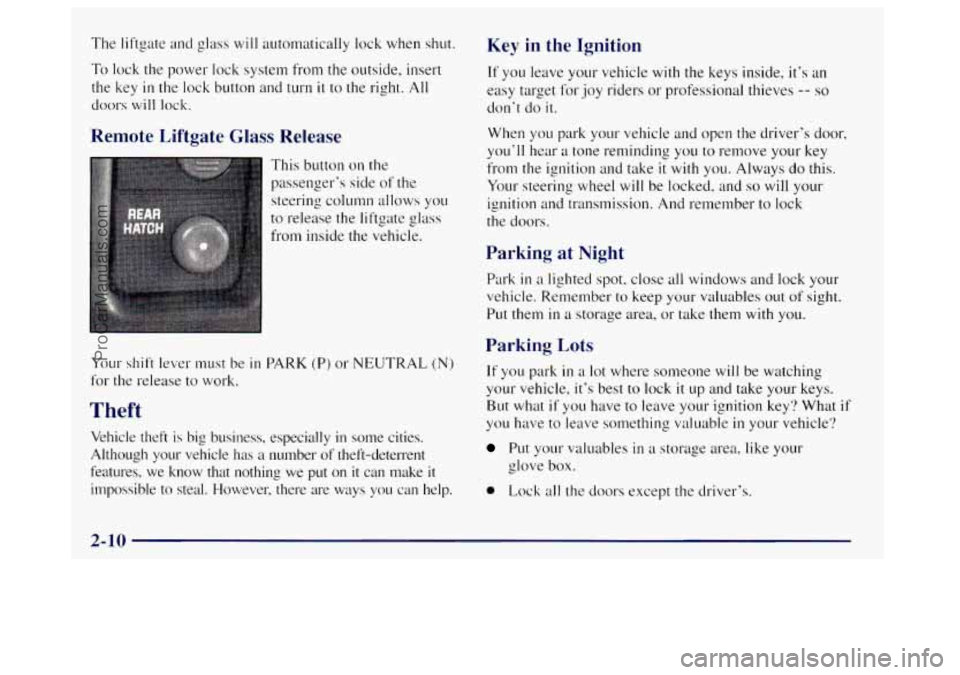
The liftgate and glass will automatically lock when shut.
To
lock the power lock system from the outside, insert
the key
in the lock button and turn it to the right. All
doors will lock.
Remote Liftgate Glass Release
This button on the
passenger’s side
of the
steering column allows you
to release the liftgate glass
from inside
the vehicle.
Key in the Ignition
If you leave your vehicle with the keys inside, it’s an
easy target for joy riders or professional thieves
-- so
don’t do it.
When you park your vehicle and open the driver’s door,
you’ll hear
a tone reminding you to remove your key
from the ignition
and take it with you. Always do this.
Your steering wheel
will be locked, and so will your
ignition and transmission. And remember to lock
the doors.
Parking at Night
Park in a lighted spot, close all windows and lock your
vehicle. Remember
to keep your valuables out of sight.
Put
them in a storage area, or take them with you.
Your shift lever must be
in PARK (P) or NEUTRAL (N)
for the release to work.
Theft
Vehicle theft is big business, especially in some cities.
Although your vehicle
has a number of theft-deterrent
features, we know that nothing we put
on it can make it
impossible to steal. However, there are ways you can help.
Parking Lots
If you park in a lot where someone will be watching
your vehicle, it’s best to lock
it up and take your keys.
But what
if you have to leave your ignition key‘? What if
you have to leave something valuable in your vehicle?
Put your valuables in a storage area, like your
glove box.
0 Lock all the doors except the driver’s.
2-10
ProCarManuals.com
Page 75 of 380
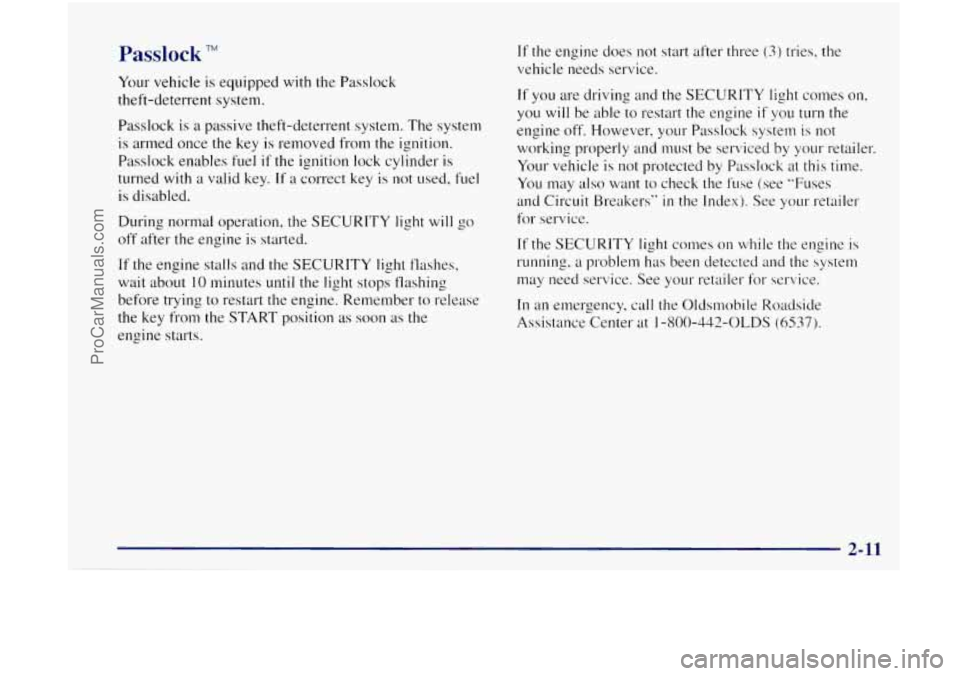
Passlock TM
Your vehicle is equipped with the Passlock
theft-deterrent system.
Passlock
is a passive theft-deterrent system. The system
is armed once the
key is removed from the ignition.
Passlock enables fuel if the ignition lock cylinder
is
turned with a valid key. If a correct key is not used, fuel
is disabled.
During normal operation, the SECURITY light will go
off after the engine is started.
If the engine stalls and the SECURITY light flashes,
wait about
10 minutes until the light stops flashing
before trying to restart the engine. Remember to release
the key from the START position
as soon as the
engine starts.
If the engine does not start after three (3) tries, the
vehicle needs service.
If you are driving and the SECURITY light comes on,
you will be able to restart the engine if you turn the
engine off. However, your Passlock system is not
working properly and must be serviced by your retailer.
Your vehicle is not protected by Passlock at this time.
You may
also want to check the fuse (see “Fuses
and Circuit Breakers” in the Index). See your retailer
for service.
If the SECURITY light comes on while the engine is
running, a problem has been detected and the system
may need service. See your retailer for service.
In an emergency, call the Oldsmobile Roadside
Assistance Center at
1 -800-442-OLDS (6537).
ProCarManuals.com
Page 76 of 380
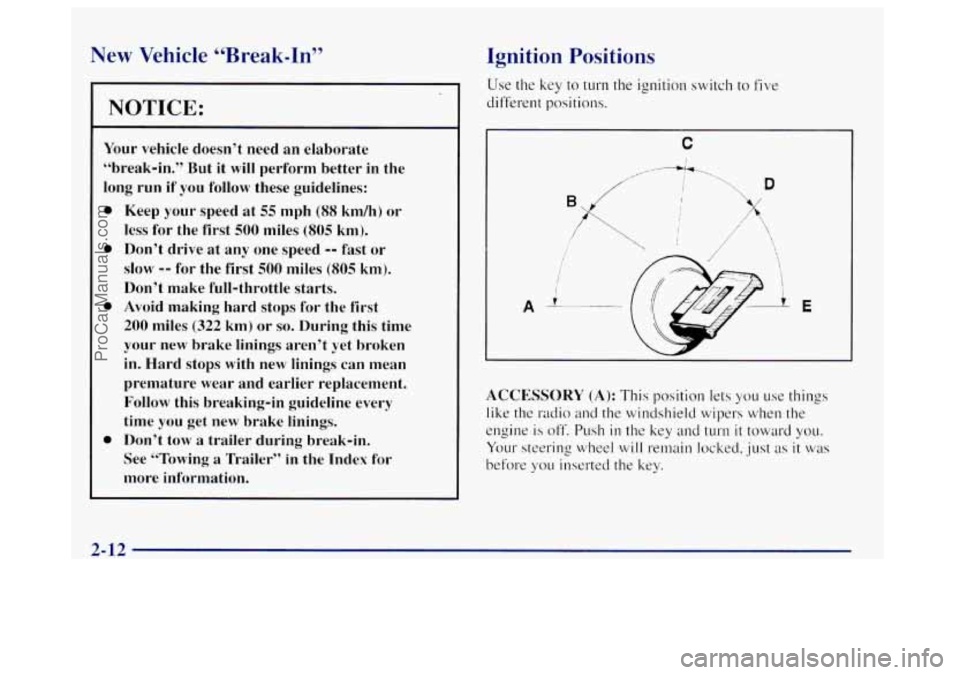
New Vehicle “Break-In”
NOTICE:
Your vehicle doesn’t need an elaborate
“break-in.” But it
will perform better in the
long run if you follow these guidelines:
a
0
a
0
Keep your speed at 55 mph (88 knlhj or
less for the first
500 miles (805 kmj.
Don’t drive at any
one speed -- fast or
slow
-- for the first 500 miles (805 km).
Don’t make full-throttle starts.
Avoid making hard stops for the first
200 miles (322 km) or so. During this time
your new brake linings aren’t yet broken
in. Hard stops with new linings can mean
premature wear and earlier replacement. Follow this breaking-in guideline every
time you get new brake linings.
Don’t tow
a trailer during break-in.
See “Towing a Trailer” in the Index for
more information.
Ignition Positions
Use the key to turn the ignition switch to five
different positions.
C
E
ACCESSORY (A): This position lets you use things
like the radio and
the windshield wipers when the
engine is off. Push in the key and turn it toward you.
Your steering wheel will remain locked, just
as it was
before
yo~l inserted the key.
2-12
- . -~
ProCarManuals.com
Page 77 of 380
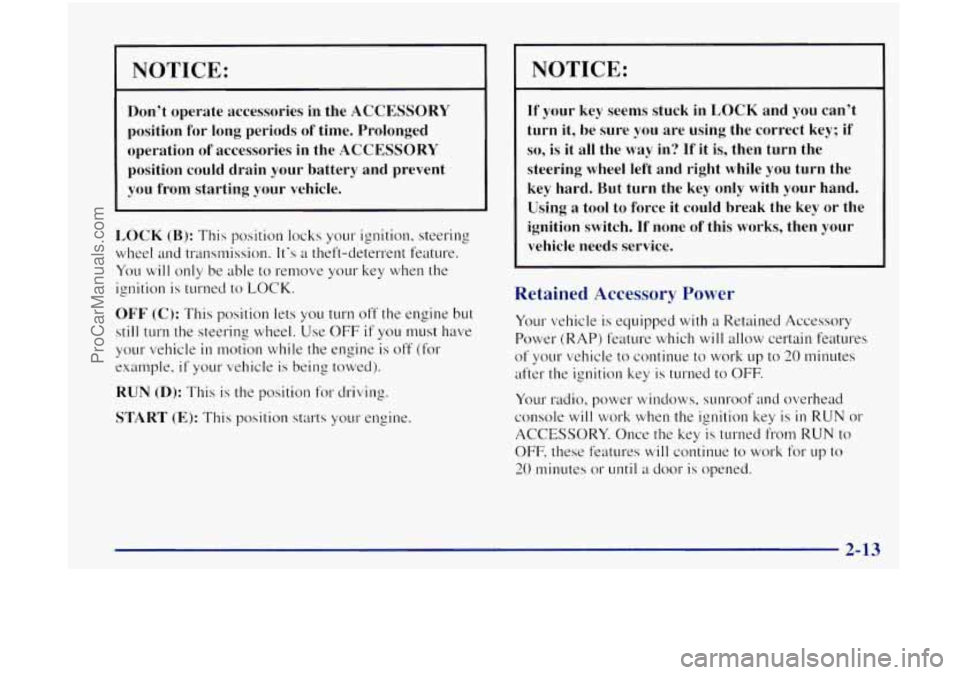
NOTICE:
Don’t operate accessories in the ACCESSORY
position for long periods of time. Prolonged
operation of accessories in the
ACCESSORY
position could drain your battery and prevent
you from starting your vehicle.
LOCK (B): This position locks your ignition, steering
wheel and transmission. It’s
a theft-deterrent feature.
You will only be able to remove your key when the
ignition is turned to
LOCK.
OFF (C): This position lets you turn off the engine but
still turn the steering wheel. Use
OFF if you must have
your vehicle
in motion while the engine is off (for
example,
if your vehicle is being towed).
RUN (D): This is the position for driving.
START (E): This position starts your engine.
NOTICE:
If your key seems stuck in LOCK and you can’t
turn it, be sure you are using the correct key; if
so, is it all the way in? If it is, then turn the
steering wheel left and right while you turn the
key hard. But turn the key only with your hand.
Using
a tool to force it could break the key or the
ignition switch.
If none of this works, then your
vehicle needs service.
Retained Accessory Power
Your vehicle is equipped with a Retained Accessory
Power (RAP) feature which will allow certain features
of your vehicle to continue to work up to 20 minutes
after the ignition
key is turned to OFF.
Your radio, power windows, sunroof and overhead
console
will work when the ignition key is in RUN or
ACCESSORY. Once the key is turned from
RUN to
OFF, these ,features will continue to work for up to
20 minutes or until a door is opened.
ProCarManuals.com
Page 79 of 380

Engine Coolant Heater (If Equipped)
In very cold weather, 0°F (-18°C) or colder, the engine
coolant heater can help.
You’ll get easier starting and
better fuel economy during engine warm-up. Usually,
the coolant heater should be plugged
in a minimum of
four hours prior to starting your vehicle.
To Use the Engine Coolant Heater
1. Turn off the engine.
2. Open the hood and unwrap the electrical cord. The
cord is located
on the driver’s side of the engine
compartment, behind the underhood fuse block.
3. Plug it into a normal, grounded 1 10-volt AC outlet.
Plugging the cord into an ungrounded outlet
could cause an electrical shock.
Also, the wrong
kind
of extension cord could overheat and cause
a fire. You could be seriously injured. Plug the
cord into
a properly grounded three-prong
110-volt
AC outlet. If the cord won’t reach, use a
heavy-duty three-prong extension cord rated
for
at least 15 amps.
4. Before starting the engine, be sure to unplug and store
the cord as it was before to keep it away from moving
engine parts.
If you don’t, it could be damaged.
How
long should you keep the coolant heater plugged
in?
The answer depends on the outside temperature, the
kind
of oil you have, and some other things. Instead of
trying to list everything here. we ask that you contact
your retailer
in the area where you’ll be parking your
vehicle. The retailer can give
yo11 the best advice for that
particular area.
ProCarManuals.com
Page 80 of 380
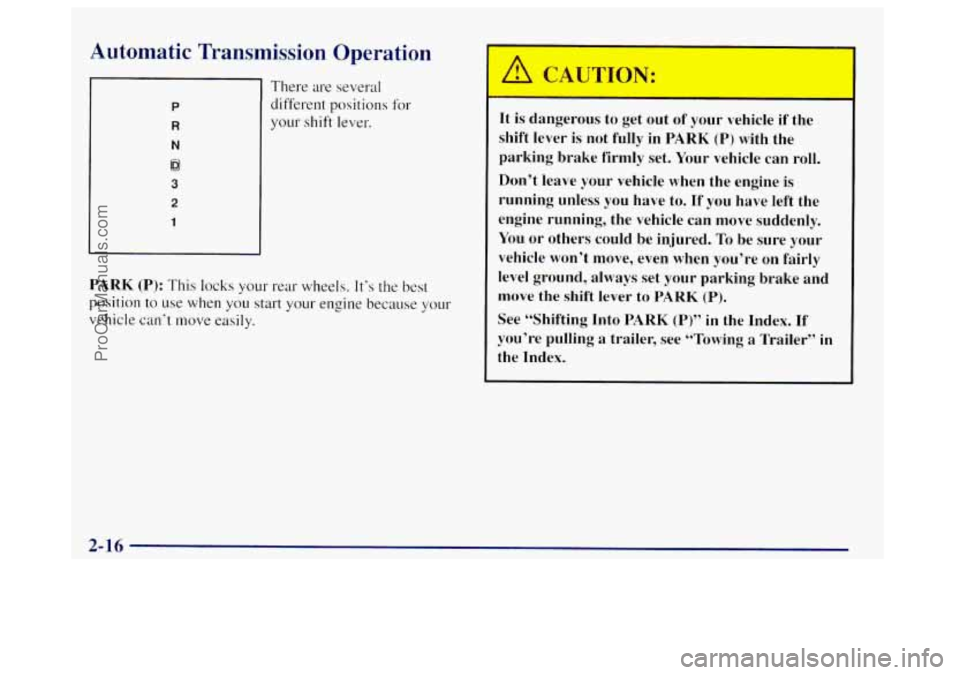
Automatic Transmission Operation
P
R
N
0
3
2
1
There are several
different positions for
your shift lever.
PARK (P): This locks your rear wheels. It’s the best
position to use when you start your engine because your
vehicle
can‘t move easily.
r
It is dangerous to get out of your vehicle if the
shift lever
is not fully in PARK (P) with the
parking brake firmly set. Your vehicle can roll.
Don’t leave your vehicle when the engine is
running unless you have to. If you have left the
engine running, the vehicle can move suddenly.
You or others could be injured. To be sure your
vehicle won’t move, even when you’re
on fairly
level ground, always set your parking brake and
move the shift lever to
PARK (P).
See “Shifting Into PARK (P)” in the Index. If
you’re pulling
a trailer, see “Towing a Trailer” in
the Index.
ProCarManuals.com
Page 81 of 380

EIISLW the shift lever is f~~lly in PARK (P) range
before starting the engine. Your vehicle has
a
Brake-Transmission Shift Interlock (BTSI). You
have to fully apply your regular brakes before you can
shift from PARK
(P) when the ignition key is in RUN.
If you cannot shift out of PARK (P), ease pressure on
the shift lever -- press the button on the shift lever and
push the shift lever
all the way into PARK (P) as you
maintain brake application. Then move the shift lever
into the gear you wish. See ”Shifting Out of PARK (P)”
in the Index.
REVERSE (R): Use this gear to back up.
NOTICE:
Shifting to REVERSE (R) while your vehicle is
moving forward could damage your
transmission. Shift
to REVERSE (R) only after
your vehicle
is stopped.
To rock your vehicle back and forth to get out of snow,
ice or sand without damaging your transmission, see
”Stuck:
In Sand, Mud, Ice or Snow’‘ in the Index.
NEUTRAL (N): In this position, your engine doesn’t
connect
with the wheels. To restart when you’re already
moving, use NEUTRAL (N) only.
Shifting out
of PARK (P) or NEUTRAL (N) while
your engine
is “racing” (running at high speed) is
dangerous. Unless your foot
is firmly on the
brake pedal, your vehicle could move very
rapidly. You could lose control and hit people or
objects. Don’t shift out of
PARK (P) or
NEUTRAL (N) while your engine is racing.
I NOTICE:
Damage to your transmission caused by shifting
out of
PARK (P) or NEUTRAL (N) with the
engine racing isn’t covered by your warranty.
ProCarManuals.com
Page 84 of 380

Shifting Into PARK (P)
c
It can be dangerous to get out of your vehicle if’
the shift lever is not fully in PARK (P) with the
parking brake firmly set. Your vehicle can roll.
If
you have left the engine running, the vehicle can
move suddenly. You or others could be injured.
To be sure your vehicle won’t move, even when
you’re on fairly level ground, use the steps that
follow. If you’re pulling a trailer, see “Towing a
Trailer” in the Index.
1. Hold the brake pedal down with your right foot and
set the parking brake.
!. Move the shift lever into PARK (P) position like this:
P
a
Hold in the button on the lever.
Push the lever all the way toward the front of
the vehicle.
3. Turn the ignition key to LOCK.
4. Remove the key and t,&e it with you. If you can leave
your vehicle
with the key, your vehicle is in PARK (P).
2-20
ProCarManuals.com
Page 85 of 380

Leaving Your Vehicle With the
Engine
Running
4 CAUTION:
It can be dangerous to leave your vehicle with the
engine running. Your vehicle could move
suddenly if the shift lever is not fully in PARK
(P)
with the parking brake firmly set. And, if you
leave the vehicle with the engine running, it could
overheat and even catch fire. You or others could
be injured. Don’t leave your vehicle with the
engine running unless you have to.
If you have to leave your vehicle with the engine
running, be sure your vehicle is
in PARK (P) and your
parking brake is firmly set before you leave
it. After
you‘ve moved the shift lever into PARK (P), hold the
regular brake pedal down. Then, see
if you can move the
shift lever away from PARK (P) without first pulling it
toward you (or pressing the button on a console shift
lever).
If you can, it means that the shift lever wasn’t
fully locked into PARK (P).
Torque Lock
If you are parking on a hill and you don’t shift your
transmission into PARK (P) properly, the weight of the
vehicle may
put too much force on the parking pawl in
the transmission. You may find it difficult to pull the
shift lever out of PARK (P). This
is called “torque lock.”
To prevent torque lock, set the parking brake and then
shift into PARK (P) properly before you leave the
driver’s seat.
To find out how, see “Shifting Into
PARK
(P)” in the Index.
When you are ready
to drive, move the shift lever out of
PARK
(P) bqjot-e you release the parking brake.
If torque lock does occur, you may need to have another
vehicle push yours a little
uphill to take some of the
pressure
f1-0111 the parking pawl in the transmission, so
you can pull the shift lever out of PARK (P).
2-21
ProCarManuals.com
Page 86 of 380
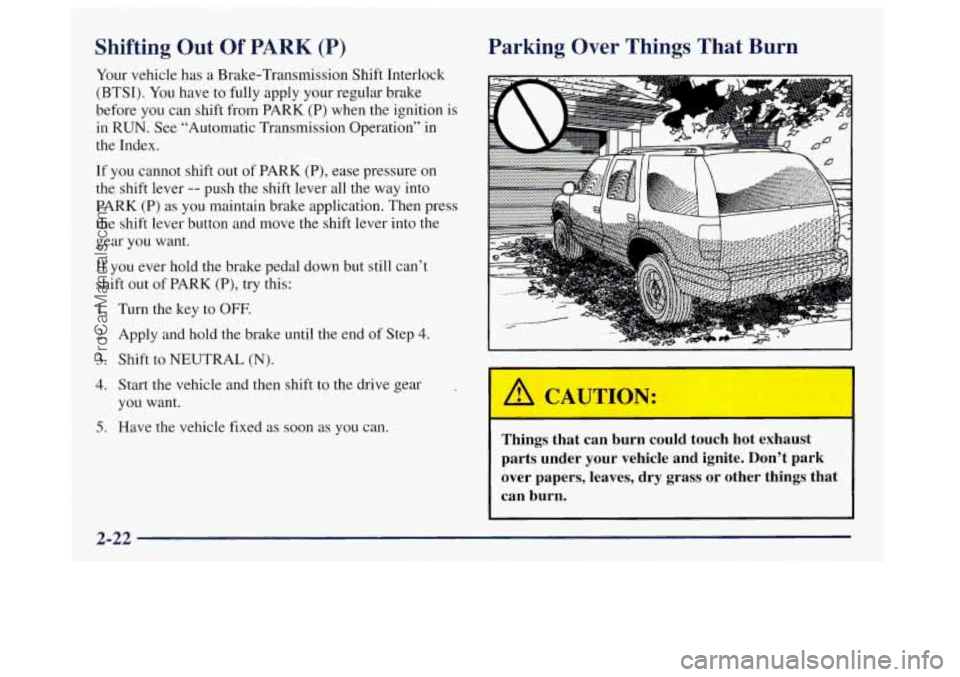
Shifting Out Of PARK (P)
Your vehicle has a Brake-Transmission Shift Interlock
(BTSI).
You have to fully apply your regular brake
before
you can shift from PARK (P) when the ignition is
in
RUN. See “Automatic Transmission Operation” in
the Index.
If you cannot shift out of PARK
(P), ease pressure on
the shift lever
-- push the shift lever all the way into
PARK
(P) as you maintain brake application. Then press
the shift lever button and move the shift lever into the
gear you want.
If you ever hold the brake pedal down but still can’t
shift
out of PARK (P), try this:
1. Turn the key to OFF.
2. Apply and hold the brake until the end of Step 4.
3. Shift to NEUTRAL (N).
4. Start the vehicle and then shift to the drive gear
you want.
5. Have the vehicle fixed as soon as you can.
Parking Over Things That Burn
I I
Things that can burn could touch hot exhaust
parts under your vehicle and ignite. Don’t park
over papers, leaves, dry grass or other things that
can burn.
2-22
ProCarManuals.com